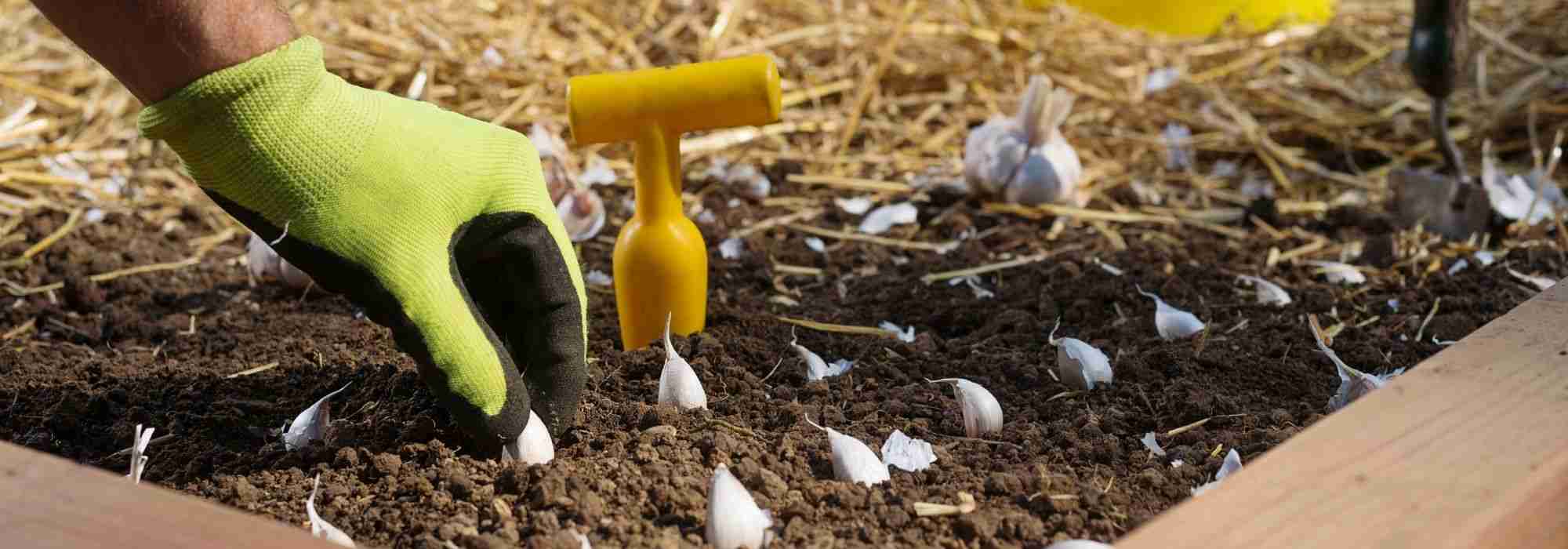
Vegetable garden calendar - February
Sowing and planting
Contents
In February, it’s time to pull on gloves and boots again to gently rediscover joys of gardening you may already have been missing. After taking stock, it’s usually at this time that gardeners order the vegetable seeds they will need this year.
Some sowings can begin in February, but be vigilant about frost to avoid damaging their development.
Discover what to do in the vegetable patch in February!
Frost-tender vegetables to sow indoors at home
For gardeners in a hurry, it is possible to start the sowing of some vegetables and vegetable-fruits generally as early as February (sometimes from the second half of January in particularly mild areas) if you intend these young plants to be grown under glass. You will need a heated space (about 15 to 20 degrees) for good germination and a bright area to ensure their proper development before transplanting to the garden. This transplanting will take place at the start of spring, once the Ice Saints have passed. Sun-loving vegetables lead the way :
Chillies, peppers and aubergines are sown early (from mid-February) because they grow slowly. Sow them in seed trays or buckets, in a heated greenhouse or in a bright spot in your home. Below 13 degrees, their growth is interrupted; ideal is between 15 and 20 degrees.
Discover all the secrets of growing aubergines, peppers and chillies.
Fill trays or buckets with potting soil, space seeds one to two centimetres apart, and cover with a thin layer of potting soil. Mist rather than water to avoid dislodging the seeds.
For more details, see our advice sheet for successful tomato growing.
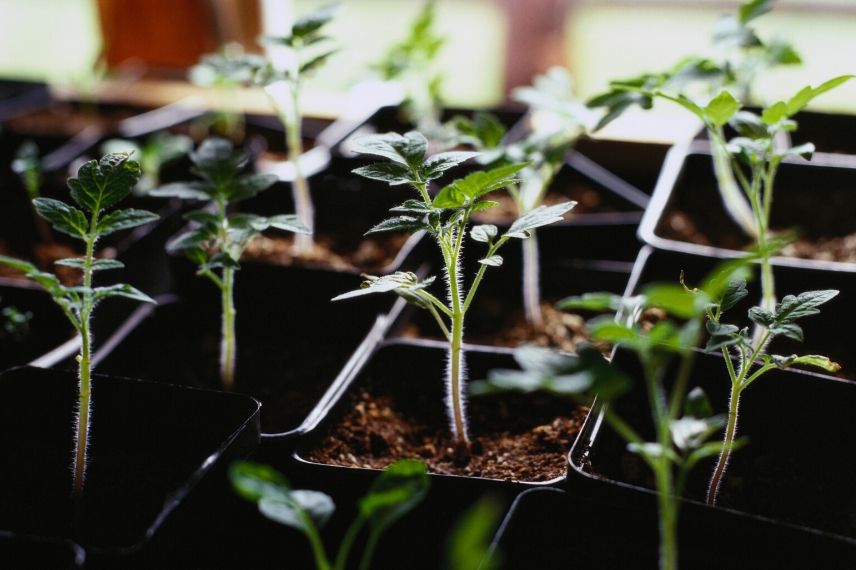
Tomato sowing
-
Celeriac
Celeriac sowing is long and rather delicate. Germination requires warmth and humidity; it is possible to carry out the sowing indoors to transplant later to the vegetable garden. At the end of February, it is possible to start celeriac sowing. Germination takes around 12 to 15 days. We particularly like the ‘Goliath’ variety, a robust celeriac, resistant to bolting, with good storage qualities and little susceptibility to rust.
To succeed with celeriac sowing and growing, consult our family sheet: Celeriac, celery: sow, plant, grow and harvest.
Read also
Vegetable garden calendar - JanuaryVegetables to sow under unheated cover
Many vegetables do not need heat to germinate and a simple cold frame or tunnel is enough to protect your sowings from cold at end of winter. You can then sow first vegetables there and, with first rays of sun, small seedlings will appear. To obtain early harvests, you can sow from late February, directly in open ground:
-
The lettuces
Leaf vegetables par excellence, lettuces (Batavia, romaine, oakleaf…) can be sown from February under a cold frame. We recommend the butterhead lettuce ‘Reine de Mai’, an old early variety, tasty and crunchy, particularly suited to spring growing. Sowing is child’s play: directly in open ground or in a seed tray, sow seeds taking care not to sow too densely. For more information, read our advice sheet: Succeeding in growing lettuces, from sowing to harvest.
If you need to transplant them, wait until young plants have four leaves.
-
Summer leeks
To harvest in summer, sow from February, ideally directly in open ground or in a seed tray. Some varieties are particularly suitable such as ‘Gros long d’été’ (best reserved for southern regions as it does not tolerate severe cold) or ‘Géant Précoce’, a very hardy, productive variety that produces very large boles. For germination, seeds need a temperature of at least 13°C. Leek seeds can take 2 to 3 weeks to show. Once emerged, transplant when diameter reaches that of a pencil, which usually takes a further 2 to 3 months depending on sowing. For everything about this vegetable, see our family sheet: Leeks: sow, plant, grow, harvest.
-
The radishes
Sow directly in open ground under a cold frame or tunnel — these are called forcing radishes, such as variety ‘French Breakfast’. Sowing is easy and seeds germinate quickly (3 to 5 days at 7°C). Again, sow thinly: seeds are fairly large, space them about 3 cm apart. A useful tip is to sow a rank every 2 to 3 weeks to stagger harvests. If you prefer convenience, consider seed tapes, notably for the scarlet round forcing radish! Finally, control watering carefully because the drier they are, the spicier and more fibrous they become.
Radishes will hold no secrets for you thanks to our family sheet: Radish: sow, grow, harvest.
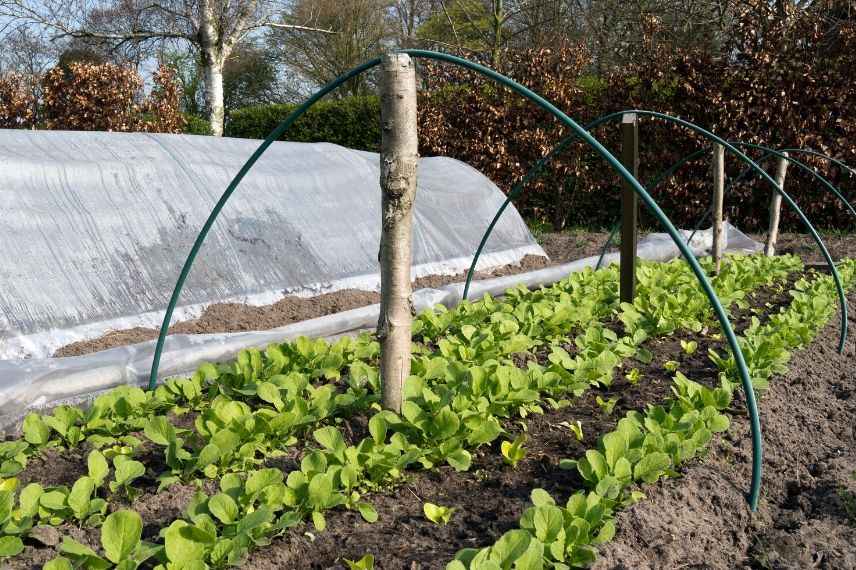
Radish grown under tunnel
-
The cauliflowers
Variety ‘Merveille de toutes saisons’ is ideal. Sow in a seed tray, cover seeds with a fine layer of soil then mist. Seedlings will appear 10 to 15 days later. Then transplant to garden when seedlings have four true leaves.
Read our advice sheet to succeed in growing cauliflower.
-
Spring turnips
It is also possible to sow turnips from February. Sow in rich soil, 1–2 cm deep, then thin to 10 cm as first leaves appear. Spring turnips are harvested between May and July according to needs. Prefer the following varieties well suited to early sowing: Atlantic pink-collar turnip for forcing, early Auvergne turnip, or Snowball turnip.
Discover our family sheet Turnip: sowing, cultivation and maintenance to succeed with them.
-
The carrots
Sow carrots in their final position under a tunnel or cold frame; early carrots can be sown broadcast. Cover seeds with a fine layer of soil; if sown too deeply they will not germinate. We particularly like carrot ‘Saint Valéry’, an old, very productive variety.
Discover everything to know about sowing and growing carrots!
Discover other Sowing and planting in February
View all →Available in 1 sizes
Available in 0 sizes
Available in 1 sizes
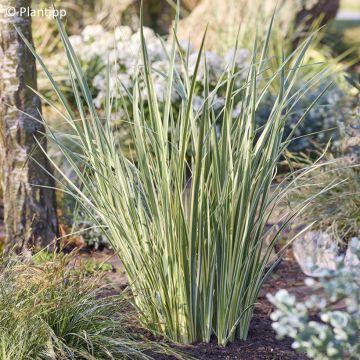
Available in 1 sizes
Available in 1 sizes
Available in 1 sizes
Available in 1 sizes
Available in 2 sizes
Available in 1 sizes
Available in 1 sizes
Sowing in open ground
Some vegetables are less shy in the face of winter’s freezing temperatures and sowing can be done directly in open ground :
Pretty easy to remember: sow one seed in a seed tray every 5 cm and at 5 cm depth. Emergence depends on temperature — the colder it is, the longer it will take.
To learn everything about its cultivation, read: Broad bean: sow, to grow, harvest.
In cool climate, we recommend sowing broad beans from February. Whereas in the south-western half, you can sow in October–November. Before sowing, soak seeds for 24 hours to promote germination. Sowing is done in situ, directly in their final position. They are not transplanted. We recommend the dwarf mangetout pea ‘Norli’, a vigorous, hardy variety with beautiful light green pods.
Discover our family sheet: Peas and petit pois: sow, to grow, harvest in vegetable garden.
-
Spring spinach
Varieties such as ‘Matador’ or ‘Junius’ (resistant to downy mildew) can be sown early, from mid-February. Beware, spinach always needs moist soil! Our tip is to sow them in a shaded area of your vegetable garden, spacing them a little wider to save water.
Read Spinach: sowing, to grow and harvesting in the vegetable garden to succeed in their cultivation.
-
Spring onions
Now is the time to sow spring onions, directly in place. The White Spring Parisian onion is early and frost-hardy. It is sown from February. We also recommend the red Florence onion, Simiane variety, sweet and delicious raw in salads, and the ‘Stuttgart’, a large yellow onion, slightly flattened, with good yield and good keeping quality.
To learn more about onions, consult our sheet: Onion: sowing, planting, cultivation, harvest.
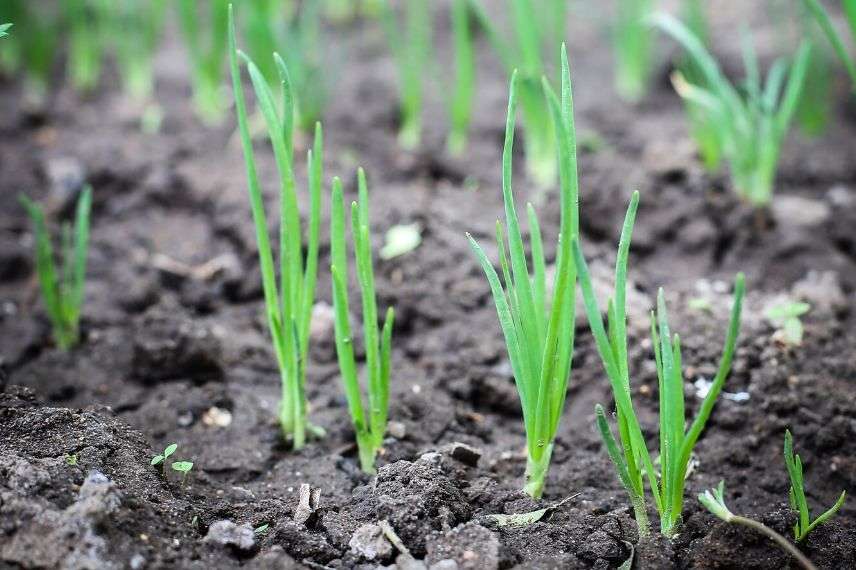
Onion sowing
Chives can be sown from February under cover, either at home in a bright unheated room or in a cold greenhouse. Sow in a seed tray at 2–3 mm depth, spacing seeds 5–7 cm apart.
Do not hesitate to read our sheet: Chives: plant, sow, divide.
Vegetables to plant in the vegetable patch
As with January, you can still plant garlic but in February you can add onions and shallots, which can be planted as bulblets if you do not want to sow.
The Clédor pink garlic is a spring variety we particularly like: late and very fragrant, it shows long dormancy (so late germination) and has excellent keeping quality.
Feel free to consult our information sheet: Garlic: planting, growing, harvesting in the vegetable garden.
Onion bulblets can be planted from late February, in rows. We recommend Red Baron, an early variety with a mild, sweet flavour, Centurion, which offers very good yields and excellent keeping quality, or Rosé de Roscoff, prized for excellent eating quality.
For everything on growing onions, read Onion: sowing, planting, cultivation, harvest.
-
Shallot
Plant in ranks spaced 20 cm between each bulblet. We have a soft spot for the Jermor, with pink flesh and a very aromatic flavour. It is a productive, late variety that keeps very well.
On the blog, find Ingrid’s tips for planting garlic, onion and shallot: Garlic, onion, shallot… it’s February in the vegetable garden!
In mild climate, you can plant first potatoes. Elsewhere, set your young plants to sprout in a bright place for six weeks before planting them.
In February, in the vegetable patch, it’s also a good time to…
- Add compost to areas of your vegetable plot that you will soon cultivate,
- Prepare potato planting under cover or using cloches. All our advice to successfully grow, harvest and store potatoes is here.
- Spread ramial chipped wood (RCW). It’s not too late yet.
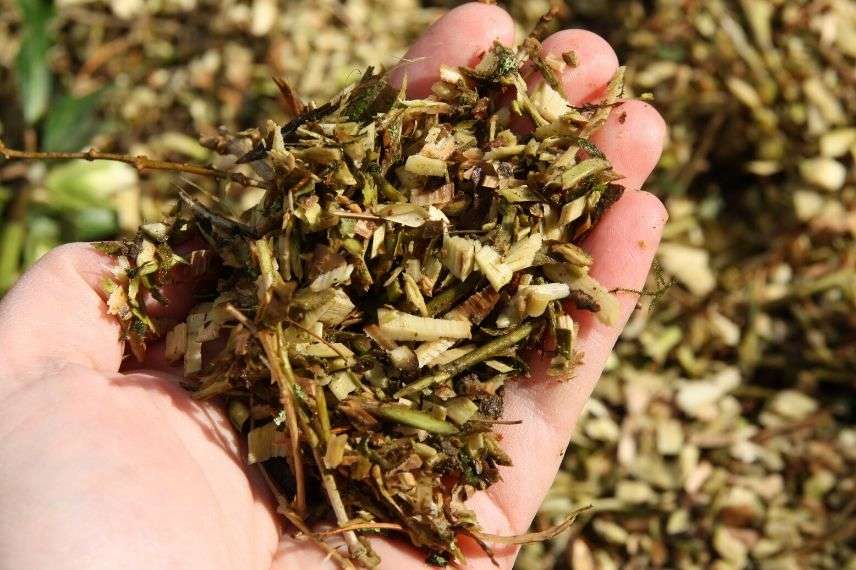
Ramial chipped wood mulch
Sowing, planting and harvest calendar
| Jan | Feb | Mar | Apr | May | Jun | Jul | Aug | Sep | Oct | Nov | Dec | |||||||||||||
| Pink garlic | ||||||||||||||||||||||||
| Aubergine | ||||||||||||||||||||||||
| Carrot | ||||||||||||||||||||||||
| Celeriac | ||||||||||||||||||||||||
| Cauliflower | ||||||||||||||||||||||||
| Shallot | ||||||||||||||||||||||||
| Broad bean | ||||||||||||||||||||||||
| Cutting lettuce | ||||||||||||||||||||||||
| Spring lettuce | ||||||||||||||||||||||||
| Turnip | ||||||||||||||||||||||||
| Onion | ||||||||||||||||||||||||
| Chilli / pepper | ||||||||||||||||||||||||
| Summer leek | ||||||||||||||||||||||||
| Round-seeded pea | ||||||||||||||||||||||||
| Mange-tout | ||||||||||||||||||||||||
| Forcing radish | ||||||||||||||||||||||||
| Sowing | |
| Pricking out, planting | |
| Harvest |
please note
This sowing calendar is provided as a guide. Bear in mind that sowing, pricking out, planting and harvest times may be earlier or later depending on region and weather. Different varieties of the same vegetable can also result in earlier or later harvests.
You can refer to our map to find out which climate zone corresponds to your geographical area.
Before sowing or planting your vegetables and herbs, take account of the weather and check the forecast for the coming days. Indeed, no garden is immune to a late frost that could jeopardise germination or survival of young seedlings. Likewise, assess condition of your soil… if it is waterlogged or particularly cold, wait a while!
- Subscribe!
- Contents

































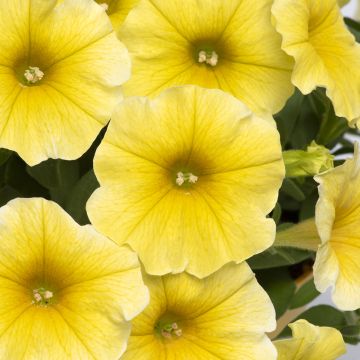




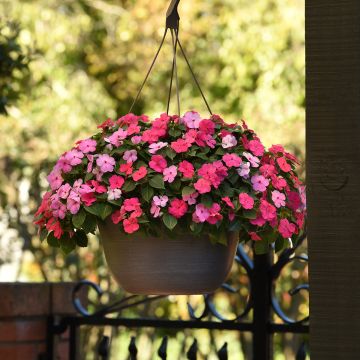

Comments